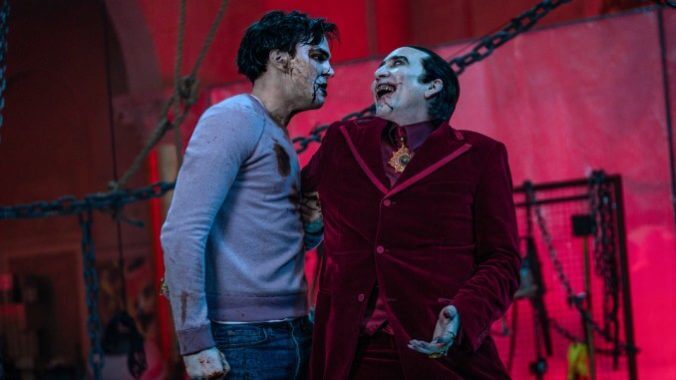Renfield Stakes It All on a Bad Joke

In Bram Stoker’s 1897 novel Dracula, R.M. Renfield is a lunatic patient under the care of Dr. John Seward, whose delusions of lifeforce power gained from the ingestion of insects and small creatures come about from the brief relationship he forms with the Count. Within his cell in the asylum, Dracula supplies Renfield with insects and a false promise of immortality in exchange for getting him within proximity of his next desired victim: Mina Harker. Chris McKay’s Renfield doesn’t draw from the Renfield of Stoker’s novel, but the Renfield of Tod Browning’s 1931 horror classic, itself adapted from Hamilton Deane’s 1924 stage play. In the Bela Lugosi film, it is Renfield, not Jonathan Harker (as in the novel), who acts as the real estate solicitor and Dracula’s first point of contact at his castle, and it’s this visit which drives Renfield to insanity and turns him into Dracula’s devoted servant–the Renfield we all know and love.
Thus, following the events of the 1931 film, Renfield takes Browning’s iteration of this character dynamic and propels it nearly 100 years into the future. Robert Montague Renfield (Nicholas Hoult) and Dracula (Nicolas Cage) have now spent the better part of a century together traveling the globe, acquiring victims for Dracula to feast on. But the devotion Renfield once felt towards his master is starting to fade and progress to exhaustion. He’s beginning to realize that, perhaps, he has been in the throes of a “toxic relationship,” the kind that would only have become clear in the self-care-obsessed world of 2023. How silly! That’s the premise of The Lego Batman Movie and The Tomorrow War director’s third film, a gag premise built on the latent push for therapy speak and self-love which (at this point, very sinisterly) permeates much of modern Western pop culture. But it’s a silly premise in an insecure and tonally incoherent film. It’s not willing to be goofy and gonzo enough for the inanity of its concept, not cool enough for the slick fight scenes it wants to impress you with, and not worthy enough of Cage as Dracula (the real star of this show).
Renfield and Dracula have posted up in New Orleans following another one of Dracula’s feeding frenzies, which Renfield explains in an opening “Yep that’s me. You’re probably wondering how I got here” voiceover monologue, complete with freeze frame but surprisingly sans record scratch. These frenzies tend to climax with a big fight that renders Dracula alive but physically compromised, needing to flee to a safe place to regain full power and begin feeding again. While Drac recuperates in an abandoned hospital, Renfield attends group meetings for people in abusive and toxic relationships, hoping to use the abusers as fodder for Dracula’s bloodlust. But instead of finding Dracula suitable victims–Dracula protests that one such group of lowlifes do not have “pure enough blood” for him–Renfield acquires the faculties necessary to enact self-care and slowly disengage from his problematic relationship.
Things become complicated for Renfield on his journey towards self-actualization when a group of ruthless criminals led by Teddy Lobo (Ben Schwartz) seeks revenge on the traffic cop who’s been relentlessly pursuing him for the death of her police captain father. In the same bar that they’ve decided to hold officer Rebecca Quincy (Awkwafina) hostage, Renfield decides to consume some of the bugs that, in this universe, really do give him superhuman abilities—abilities to wipe out all the bad guys almost single-handedly. Deemed a hero by Quincy, Renfield is now simultaneously being pursued by the head of the syndicate—Teddy’s mom Ella (Shohreh Aghdashloo)–and a scorned Dracula, crushed that his once-faithful servant would stoop so low as to save the victims he should be serving up as food.
-

-

-

-

-

-

-

-

-

-

-

-

-

-

-

-

-

-

-

-

-

-

-

-

-

-

-

-

-

-

-

-

-

-

-

-

-

-

-

-








































